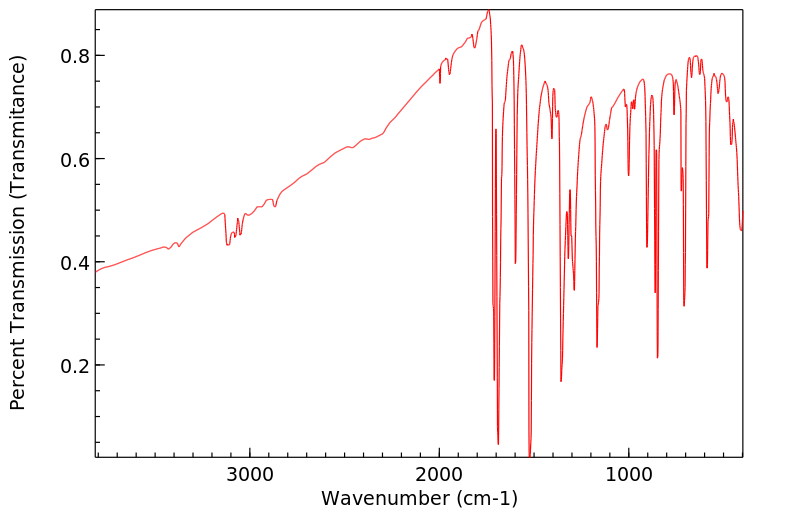1-(4-硝基苯基)-1,2-丙二酮 | 6159-25-7
中文名称
1-(4-硝基苯基)-1,2-丙二酮
中文别名
1-(4-硝基苯基)丙烷-1,2-二酮
英文名称
1-<(4-nitro)-phenyl>-1,2-propandione
英文别名
1-(4-nitrophenyl)-1,2-propanedione;1-(4-nitrophenyl)propane-1,2-dione;4-nitrophenylpropan-1,2-dione;1-(4-nitro-phenyl)-propane-1,2-dione;1-(4-Nitro-phenyl)-propan-1,2-dion;1-(4'-Nitrophenyl)-propandion-(1,2)
CAS
6159-25-7
化学式
C9H7NO4
mdl
MFCD01882876
分子量
193.159
InChiKey
WCQBWJSIZYUMDJ-UHFFFAOYSA-N
BEILSTEIN
——
EINECS
——
-
物化性质
-
计算性质
-
ADMET
-
安全信息
-
SDS
-
制备方法与用途
-
上下游信息
-
文献信息
-
表征谱图
-
同类化合物
-
相关功能分类
-
相关结构分类
物化性质
-
熔点:86-88
-
沸点:52-54°C/0.05mm
-
密度:1.319±0.06 g/cm3(Predicted)
计算性质
-
辛醇/水分配系数(LogP):1.1
-
重原子数:14
-
可旋转键数:2
-
环数:1.0
-
sp3杂化的碳原子比例:0.111
-
拓扑面积:80
-
氢给体数:0
-
氢受体数:4
安全信息
-
危险等级:IRRITANT
-
危险品标志:Xi
-
海关编码:2914700090
SDS
上下游信息
-
上游原料
中文名称 英文名称 CAS号 化学式 分子量 3-(4-硝基-苯基)-2,4-戊二酮 3-(4-nitrophenyl)pentane-2,4-dione 89185-83-1 C11H11NO4 221.213 对硝基苯甲醛 4-nitrobenzaldehdye 555-16-8 C7H5NO3 151.122 N-[3-羟基-1-(4-硝基苯基)-1-氧代-2-丙烷]乙酰胺 (R)-(+)-α-Acetamino-β-hydroxy-p-nitro-propiophenon 3123-13-5 C11H12N2O5 252.227 —— 1-(4-nitrophenyl)propane-1,2-diol 66820-59-5 C9H11NO4 197.191 —— 2-methyl-1-(4-nitrophenyl)propane-1,3-diol —— C10H13NO4 211.218 -
下游产品
中文名称 英文名称 CAS号 化学式 分子量 —— 1-(4-aminophenyl)propane-1,2-dione 10557-28-5 C9H9NO2 163.176
反应信息
-
作为反应物:描述:1-(4-硝基苯基)-1,2-丙二酮 在 transaminase 、 磷酸吡哆醛 、 铁粉 、 氯化铵 作用下, 以 乙醇 、 水 、 二甲基亚砜 为溶剂, 反应 73.0h, 生成 methyl 2,5-dimethyl-4-(4-aminophenyl)-1H-pyrrole-3-carboxylate参考文献:名称:Transaminase-Mediated Amine Borrowing via Shuttle Biocatalysis摘要:DOI:10.1021/acs.orglett.1c03320
-
作为产物:参考文献:名称:Iliceto; Patron, Annali di Chimica, 1956, vol. 46, p. 267,272摘要:DOI:
文献信息
-
Oxidative Release of Copper from Pharmacologic Copper Bis(thiosemicarbazonato) Compounds作者:John J. Sirois、Lillian Padgitt-Cobb、Marissa A. Gallegos、Joseph S. Beckman、Christopher M. Beaudry、James K. HurstDOI:10.1021/acs.inorgchem.8b00853日期:2018.8.62-Pyridylazoresorcinol complexation was used to demonstrate that Cu(II) release by reaction with peroxynitrite species involved rate-limiting homolysis of the peroxy O–O bond to generate secondary oxidizing radicals (NO2•, •OH, and CO3•–). Because the potentials for CuII(btsc) oxidation and reduction are ligand-dependent, varying by as much as 200 mV, it is clearly advantageous in designing therapeutic methodologies从铜-双-硫代嘧啶铜氮杂铜络合物向细胞内递送治疗性或分析性铜的机制通常涉及内源性还原剂将单电子还原为Cu(I)类似物的机制,从而使金属离子不稳定且与bis--不牢固地配位。硫半脲(bTSc)配体。但是,本文所述的电化学和光谱研究表明,Cu II(bTSc)和Zn II ATSM(bTSc =二乙酰基-双(4-甲基硫代半碳氮杂))复合物的单电子氧化在生理氧化剂范围内发生,导致还存在未被认可的铜释放的氧化途径。H 2 O 2氧化Cu II(bTSc)由髓过氧化物酶或辣根过氧化物酶,HOCl和牛磺酸氯胺(它们主要是由MPO催化反应在活化的中性粒细胞中产生的氯化剂)以及过氧化亚硝酸盐类(ONOOH,ONOOCO 2 –)催化的被证明。与还原不同,氧化反应通过不可逆的配体氧化进行,最终释放出Cu(II)。2-吡啶基偶氮间苯二酚络合物用于证明通过与过氧亚硝酸盐类物质反应释放Cu(II)涉及限速过氧O-
-
Fine regioselective tuning in the oxidation of sec,sec 1,2-diols by dimethyldioxirane作者:Paolo Bovicelli、Anna Sanetti、Paolo LupattelliDOI:10.1016/0040-4020(96)00615-1日期:1996.8Non symmetric sec,sec 1.2-diols and their O-isopropylidene derivatives undergo a regioselective oxidation by dimethyldioxirane depending on the electronic effects of the substituents. These results support previous views about the concerted -insertion mechanism via a polar transition state.
-
2-Iodoxybenzoic Acid Mediated Facile Conversion of 1,3-Diols to 1,2-Diketones by Oxidative Cleavage of the C-C Bond作者:J. Yadav、Swapan Biswas、R. SrinivasDOI:10.1055/s-2006-950372日期:——1,3-Diols undergo smooth oxidative cleavage of the C-C bond in the presence of 2-iodoxybenzoic acid (IBX) affording 1,2-diketones in excellent yields under mild conditions.
-
Iron-catalyzed aerobic oxidative cleavage of the C–C σ-bond using air as the oxidant: chemoselective synthesis of carbon chain-shortened aldehydes, ketones and 1,2-dicarbonyl compounds作者:Qi Xing、Hui Lv、Chungu Xia、Fuwei LiDOI:10.1039/c5cc07390a日期:——A simple iron-catalyzed aerobic oxidative C-C [sigma]-bond cleavage of ketones has been developed. Readily available and environmently benign air is used as the oxidant. This reaction prevents the use of...已经开发了酮的简单的铁催化的需氧氧化CCσ键裂解。易获得且对环境无害的空气用作氧化剂。该反应阻止使用...
-
Cobalt(II) chloride catalysed coupling of acetic anhydride with aldehydes. A novel synthesis of asymmetrical 1,2-diones
表征谱图
-
氢谱1HNMR
-
质谱MS
-
碳谱13CNMR
-
红外IR
-
拉曼Raman
-
峰位数据
-
峰位匹配
-
表征信息
同类化合物
(βS)-β-氨基-4-(4-羟基苯氧基)-3,5-二碘苯甲丙醇
(S,S)-邻甲苯基-DIPAMP
(S)-(-)-7'-〔4(S)-(苄基)恶唑-2-基]-7-二(3,5-二-叔丁基苯基)膦基-2,2',3,3'-四氢-1,1-螺二氢茚
(S)-盐酸沙丁胺醇
(S)-3-(叔丁基)-4-(2,6-二甲氧基苯基)-2,3-二氢苯并[d][1,3]氧磷杂环戊二烯
(S)-2,2'-双[双(3,5-三氟甲基苯基)膦基]-4,4',6,6'-四甲氧基联苯
(S)-1-[3,5-双(三氟甲基)苯基]-3-[1-(二甲基氨基)-3-甲基丁烷-2-基]硫脲
(R)富马酸托特罗定
(R)-(-)-盐酸尼古地平
(R)-(-)-4,12-双(二苯基膦基)[2.2]对环芳烷(1,5环辛二烯)铑(I)四氟硼酸盐
(R)-(+)-7-双(3,5-二叔丁基苯基)膦基7''-[((6-甲基吡啶-2-基甲基)氨基]-2,2'',3,3''-四氢-1,1''-螺双茚满
(R)-(+)-7-双(3,5-二叔丁基苯基)膦基7''-[(4-叔丁基吡啶-2-基甲基)氨基]-2,2'',3,3''-四氢-1,1''-螺双茚满
(R)-(+)-7-双(3,5-二叔丁基苯基)膦基7''-[(3-甲基吡啶-2-基甲基)氨基]-2,2'',3,3''-四氢-1,1''-螺双茚满
(R)-(+)-4,7-双(3,5-二-叔丁基苯基)膦基-7“-[(吡啶-2-基甲基)氨基]-2,2”,3,3'-四氢1,1'-螺二茚满
(R)-3-(叔丁基)-4-(2,6-二苯氧基苯基)-2,3-二氢苯并[d][1,3]氧杂磷杂环戊烯
(R)-2-[((二苯基膦基)甲基]吡咯烷
(R)-1-[3,5-双(三氟甲基)苯基]-3-[1-(二甲基氨基)-3-甲基丁烷-2-基]硫脲
(N-(4-甲氧基苯基)-N-甲基-3-(1-哌啶基)丙-2-烯酰胺)
(5-溴-2-羟基苯基)-4-氯苯甲酮
(5-溴-2-氯苯基)(4-羟基苯基)甲酮
(5-氧代-3-苯基-2,5-二氢-1,2,3,4-oxatriazol-3-鎓)
(4S,5R)-4-甲基-5-苯基-1,2,3-氧代噻唑烷-2,2-二氧化物-3-羧酸叔丁酯
(4S,4''S)-2,2''-亚环戊基双[4,5-二氢-4-(苯甲基)恶唑]
(4-溴苯基)-[2-氟-4-[6-[甲基(丙-2-烯基)氨基]己氧基]苯基]甲酮
(4-丁氧基苯甲基)三苯基溴化磷
(3aR,8aR)-(-)-4,4,8,8-四(3,5-二甲基苯基)四氢-2,2-二甲基-6-苯基-1,3-二氧戊环[4,5-e]二恶唑磷
(3aR,6aS)-5-氧代六氢环戊基[c]吡咯-2(1H)-羧酸酯
(2Z)-3-[[(4-氯苯基)氨基]-2-氰基丙烯酸乙酯
(2S,3S,5S)-5-(叔丁氧基甲酰氨基)-2-(N-5-噻唑基-甲氧羰基)氨基-1,6-二苯基-3-羟基己烷
(2S,2''S,3S,3''S)-3,3''-二叔丁基-4,4''-双(2,6-二甲氧基苯基)-2,2'',3,3''-四氢-2,2''-联苯并[d][1,3]氧杂磷杂戊环
(2S)-(-)-2-{[[[[3,5-双(氟代甲基)苯基]氨基]硫代甲基]氨基}-N-(二苯基甲基)-N,3,3-三甲基丁酰胺
(2S)-2-[[[[[((1S,2S)-2-氨基环己基]氨基]硫代甲基]氨基]-N-(二苯甲基)-N,3,3-三甲基丁酰胺
(2S)-2-[[[[[[((1R,2R)-2-氨基环己基]氨基]硫代甲基]氨基]-N-(二苯甲基)-N,3,3-三甲基丁酰胺
(2-硝基苯基)磷酸三酰胺
(2,6-二氯苯基)乙酰氯
(2,3-二甲氧基-5-甲基苯基)硼酸
(1S,2S,3S,5S)-5-叠氮基-3-(苯基甲氧基)-2-[(苯基甲氧基)甲基]环戊醇
(1S,2S,3R,5R)-2-(苄氧基)甲基-6-氧杂双环[3.1.0]己-3-醇
(1-(4-氟苯基)环丙基)甲胺盐酸盐
(1-(3-溴苯基)环丁基)甲胺盐酸盐
(1-(2-氯苯基)环丁基)甲胺盐酸盐
(1-(2-氟苯基)环丙基)甲胺盐酸盐
(1-(2,6-二氟苯基)环丙基)甲胺盐酸盐
(-)-去甲基西布曲明
龙蒿油
龙胆酸钠
龙胆酸叔丁酯
龙胆酸
龙胆紫-d6
龙胆紫







